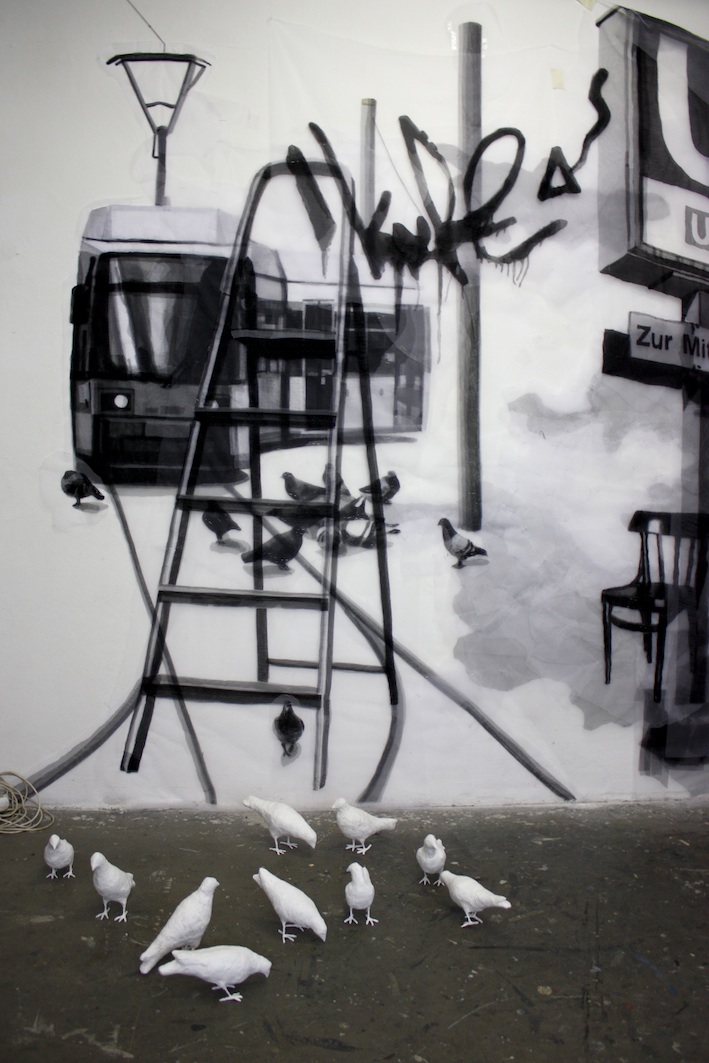RÉSONANCES ARTISTIQUES : Arts visuels – A Guide to Berlin EN
FR / EN
“A Guide to Berlin”
An exhibition by Maria and Natalia Petschatnikov (Germany)
inspired by Nabokov’s story « A Guide to Berlin »

The exhibition was shown from July 5 till July 29, 2013 at the Vladimir Nabokov Museum in St. Petersburg.
It will be shown in the « salle Europe » at the MISHA in Strasbourg, France in the Spring 2014.
Salle Europe (ground floor MISHA) April 29, 30, & May 2, 5, 6 2014. 8h-19h.
MISHA (Maison Interuniversitaire des Sciences de l’Homme – Alsace)
Campus Esplanade
5 allée du Général Rouvillois, Strasbourg, France
Tram stop: OBSERVATOIRE
“In Maria and Natalia Petschatnikov’s installation A Guide to Berlin, what at first appears to be a strikingly visual collage of heterogeneous motifs from a street scene—with trams, graffiti, pigeons, and the like—turns out to be also an exploration of the destabilizing effects of exile and loss. Taking their cue from their fellow Russian Vladimir Nabokov’s short text “A Guide to Berlin” from 1925, which playfully bypasses grandiose tourist sites in favor of icons of the humble and everyday—trams, pubs, street pipes—the artists create a reconfigurable installation that both pays homage to Nabokov’s icons and builds a new vocabulary of neglected markers of Berlin’s present. Nabokov, who lived in Berlin from 1922 to 1937 and wrote all his Russian novels here, was an “outsider” who paid attention to Berlin’s real “insiders”— things and places that are mostly overlooked. He might even be a passenger on one of the two large trams entering the exhibition space of A Guide to Berlin, which manage to seem friendly and ominous at the same time. The Petschatnikovs’ trams, wending their way out of the past and headed into an unknown future, remind us that we are all, natives and exiles alike, only in transit through this life. But their most brilliant—and Nabokovian—gesture is that the entire installation is a trompe l’oeil: the images, which appear to be drawn on the wall in charcoal, are actually made of tulle, sewn into large pieces that can be hung in various ensembles with more or less visual coherence depending on the site, thus subtly referencing the exile’s necessarily provisional relationship to his or her environment. In linking their tenancy as Russians in Berlin to their Petersburgian predecessor’s, the Petschatnikovs’ masterful delivery of visual delight invests ephemera with the eternal and asks us to reconsider our relationship to the world we encounter around us every day.”
Donna Stonecipher
American poet, author of The Cosmopolitan among others. She lives in Berlin.
« A Guide to Berlin » exhibition by Maria and Natalia Petchatnikov transformed the first floor of the Nabokov House for a few summer weeks. Tenderness towards the world around, the ability to appreciate and not take its beauty for granted is one of the prevailing themes of Nabokov’s poetry and prose of the 1920s. «Perceive the delicate rotation of the slightly tilted earth» – wrote Nabokov in “The University Poem” (translated by Dmitri Nabokov). The short story « A Guide to Berlin » was written in those years, too. The artists did not attempt to create an authentic reconstruction of the Berlin of Nabokov’s time but instead they recovered that intonation by visual means. Pigeons in a Berlin street, an approaching tram, graffiti on an invisible wall – the urban environment unfold around us is filled with Nabokov’s poetics. The exhibition lets the visitor to see contemporary Berlin through the eyes of a Nabokov’s literary character – a challenging task which the artists fully accomplished, in my opinion.
I very much hope that Maria and Natalia will be able to do further projects on Nabokov’s theme, all the more so since fate is guiding them to the most Nabokovian places of the world – St.Petersburg, the USA, France, Berlin – as if rearranging the same index cards that made up Nabokov’s text.
Tatiana Ponomareva
Director
Nabokov Museum, St. Petersburg
